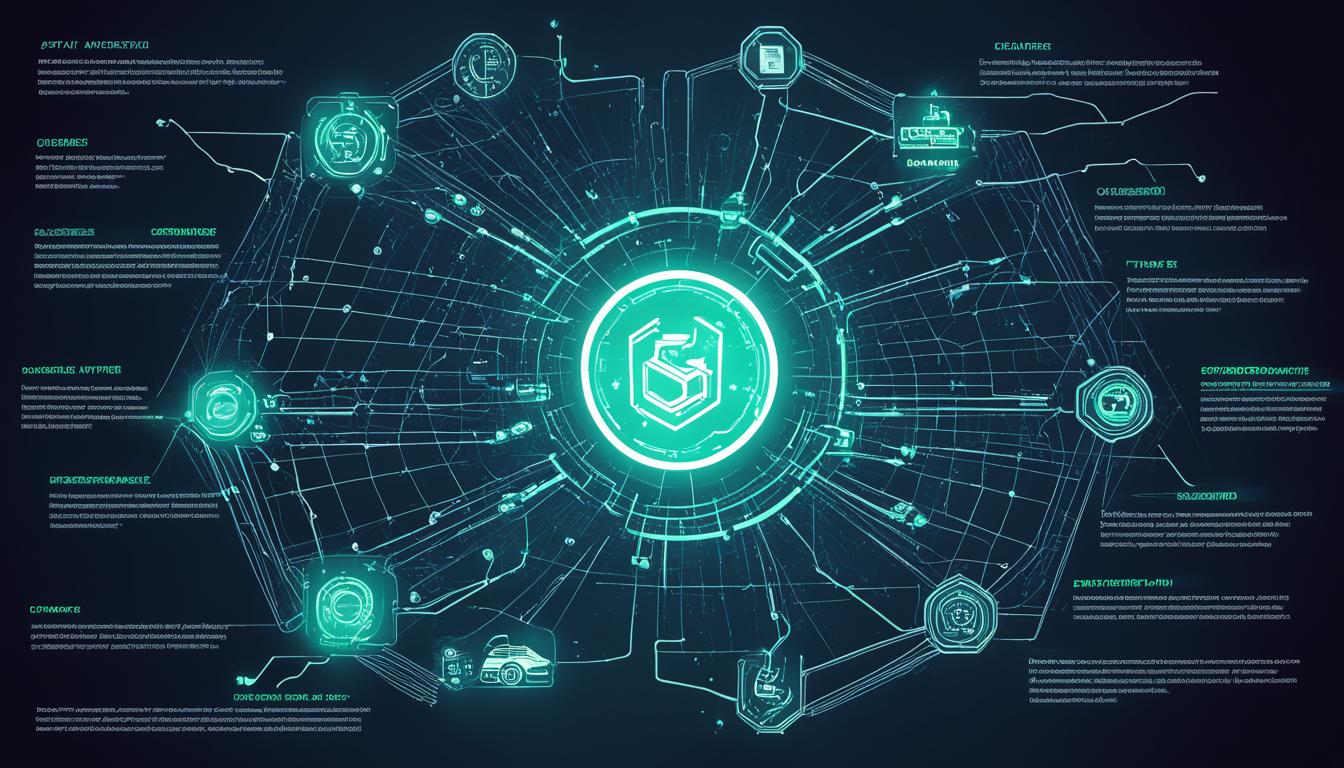Welcome to Node.js API development! Creating strong and efficient APIs is key in today's web world. Node.js offers a great foundation for this. In this guide, we will share tips and tricks for making top-quality Node.js APIs. These will be secure, well-documented, and fast.
We'll discuss everything about Node.js API development. This includes best practices, authentication, documentation, testing, and security. Our goal is to give you a full picture of how to build reliable and scalable APIs.

Key Takeaways:
- Understand the importance of Node.js APIs in modern web development.
- Implement best practices for structuring your Node.js API code.
- Secure your Node.js APIs with proper authentication mechanisms.
- Effectively document your Node.js APIs to facilitate developer adoption.
- Test your Node.js APIs thoroughly to ensure functionality and reliability.
- Optimize the performance of your Node.js APIs for a seamless user experience.
- Monitor and debug your Node.js APIs using appropriate tools and techniques.
- Implement continuous integration and deployment for seamless API delivery.
Understanding Node.js APIs
Node.js APIs are vital in today's web development. They help create strong and flexible applications. For developers aiming to use this platform's benefits, grasping Node.js APIs is key.
Node.js APIs are rules and protocols for software interactions. They're crucial in web development, allowing data and functionality to flow smoothly between applications.
Using JavaScript, Node.js lets developers build server-side applications. This makes creating APIs simpler and more direct.
Node.js APIs can handle many tasks at once without waiting on each other. This feature boosts their scalability. It's perfect for apps that deal with lots of requests all at once.
Thanks to a large open-source community, Node.js APIs have many libraries and modules. Tools like Express.js help shorten development time by offering ready-to-use features.
Node.js APIs suit many projects, from web servers to IoT devices. Their ability to adapt makes Node.js a go-to for API construction.
In short, Node.js APIs are crucial for linking different software systems. Their efficiency, wide library range, and adaptability make them a top choice for developers.
Key Features of Node.js APIs
- Non-blocking and event-driven architecture
- Extensive library support
- Scalability and efficient handling of concurrent requests
- Flexibility for various application types
Best Practices for Node.js API Development
Building Node.js APIs means following key rules to make strong, efficient apps. We'll look into important practices for Node.js API developers. These practices help streamline work, better code structure, and boost API performance.
1. Structuring Your Code
It's key to structure your code well for easy maintenance and growth. In Node.js API development, organize your code into modules. Each should handle certain API tasks. This makes teamwork easier, improves code use, and aids debugging and testing.
2. Handling Errors Effectively
Handling errors well is vital in Node.js API development. Use techniques like try-catch blocks to manage exceptions and stop your app from crashing. Also, give clear error messages and log errors to help with fixing problems.
3. Implementing API Versioning
Versioning your API helps keep things running smoothly when you make changes. With versioning, you can add features or update old ones without issue for users. This gives users flexibility and control, leading to a better experience.
"Proper code structure, good error management, and API versioning are key for top Node.js API development. Following these tips leads to organized, strong APIs that offer great user experiences."
Next, we discuss securing Node.js APIs and different ways to authenticate in Section 4.

Securing Node.js APIs
It is crucial to secure your Node.js APIs. This protects sensitive data and keeps your application safe. We will look at ways to secure your Node.js APIs. This includes authentication methods and guarding against security weaknesses.
Authentication Methods
A key factor in securing Node.js APIs is using strong authentication. A common way is token-based authentication. It generates and checks tokens for each API request. This ensures that only approved users can reach protected resources.
With token-based authentication, your Node.js API's security is boosted. Users must have a valid token for their requests. This token is given after they log in or sign up. It can expire after a certain time. This stops unauthorized access and protects user info.
Protecting Against Security Vulnerabilities
Node.js APIs can face several security risks if not secured well. It's important to know these risks and act to reduce them.
For example, Cross-Site Scripting (XSS) is a risk. It happens when harmful scripts are put into user inputs. These scripts can then run on other users' browsers. To stop XSS, validate and clean user inputs before using them.
SQL injection is another risk where attackers change SQL queries. This can lead to unauthorized database access. Using parameterized queries or prepared statements stops this.
Also, it is vital to use access controls and authorization. Role-based access control (RBAC) sets different permissions for different user roles.
"Securing your Node.js APIs is ongoing work. Strong authentication and defense against security risks keep your application and its data safe."
Securing Node.js APIs is a never-ending task. Do regular security checks, keep up with security updates, and patch vulnerabilities. This ensures your API stays secure and reliable.
We're going to talk about testing strategies for Node.js APIs next. They make sure your APIs are reliable and work well. Stay tuned!
Efficient Testing for Node.js APIs
Testing is key to making Node.js APIs that work well and are reliable. By doing comprehensive testing, your APIs will perform correctly and provide a good experience for users. We’ll look at various testing approaches for Node.js APIs here.
Unit Testing
Unit testing checks individual parts of your API on their own. It aims to make sure smaller sections, like functions, work right. These tests find and fix bugs early, keeping the code quality high and easy to manage.
For unit testing Node.js APIs, Mocha and Jest are great choices. They help organize test cases and suites in a clear way.
Integration Testing
Integration testing looks at how different parts of your API work together. It checks that the API functions correctly as a whole. This testing confirms that all components interact as they should.
With Node.js APIs, SuperTest and Chai HTTP are useful for integration testing. These tools let you test HTTP interactions, making it easier to check your API’s behavior.
End-to-End Testing
End-to-end testing reviews your API’s full operation, including all its parts and services. It mirrors real use cases and checks if the API is reliable and works as intended.
Cypress and Nightwatch.js are tools you can use for this in Node.js. They offer a way to automate and test complex scenarios with your API.
Choosing the Right Test Strategy
Picking the correct test method depends on what your project needs. Using a mix of unit, integration, and sometimes, end-to-end testing ensures thorough testing.
"Testing shows the presence, not the absence of bugs." - Edsger W. Dijkstra
Good testing practices can find bugs and issues early on. This improves your Node.js APIs in quality, reliability, and performance.

| Testing Strategy | Advantages | Disadvantages |
|---|---|---|
| Unit Testing | 1. Identifies code-level issues 2. Improves code maintainability 3. Faster execution |
1. Limited scope, doesn't test integration 2. Requires mocking of dependencies |
| Integration Testing | 1. Tests component interactions 2. Validates API functionality |
1. Slower execution compared to unit testing 2. May require additional setup |
| End-to-End Testing | 1. Tests complete API flow 2. Validates system integration |
1. Slower execution compared to unit and integration testing 2. More complex setup and maintenance |
Effective Documentation for Node.js APIs
Documentation is key for developers to fully use your Node.js APIs. It helps save time, lower errors, and increase usage. This part offers tips on making your documentation clear and easy to use.
Why Documentation Matters
Good documentation is vital for developers. Without it, they may not understand your APIs. This can lead to frustration and wasted time. Documentation guides them, offering the needed info to use your APIs well.
Making great documentation improves the developer experience. It also boosts adoption and your reputation for quality APIs.
Key Components of Effective Documentation
To make helpful documentation for your Node.js APIs, include these:
- API Reference: Give a detailed overview of the endpoints, methods, parameters, and responses. Use clear explanations and examples.
- Code Examples: Show how to use your API with real code. These should highlight common uses and best practices.
- Usage Guides: Provide step-by-step guides for common tasks. These are great for new users or those needing extra help.
- Tutorials: Offer in-depth tutorials for advanced topics. These can help developers maximize your API's capabilities.
- Changelog: Keep a changelog of updates and fixes. It keeps developers informed about changes.
API Documentation Tools
There are tools to help document your Node.js APIs. These tools have features like automatic generation, interactive explorers, and team collaboration. Some popular ones are:
These tools make documenting your APIs easier and more professional.
Good documentation helps developers and makes your Node.js APIs successful. By dedicating time to clear documentation, you enhance developer satisfaction and position your APIs as go-to resources.
Performance Optimization for Node.js APIs
Making your Node.js APIs work faster is key to a good user experience. You can make your APIs faster and more able to handle many users by using special tools and techniques designed for Node.js.
1. Efficient Code Implementation
Writing clean and efficient code is key to making your Node.js APIs fast. Here are some important tips:
- Use asynchronous operations: Use Node.js's ability to do many things at once to handle lots of requests without slowing down.
- Implement caching: Use caching, with in-memory caching or Redis, to save data that gets asked for a lot. This way, your system doesn't have to redo calculations.
- Optimize database queries: Make your database queries faster by using indexes and getting only the data you need.
- Minify and compress code: Make your code smaller and faster to load by minifying and compressing it.
2. Load Testing and Performance Monitoring
To make your Node.js APIs better, you must test how much load they can handle and keep an eye on how they perform. Keep these points in mind:
- Load testing: Use tools like Artillery or k6 to mimic lots of users using your API at once. This lets you find and fix performance problems.
- Performance monitoring: Keep tabs on how your Node.js APIs are doing with tools like New Relic or pm2. Seeing the performance in real-time helps you make quick improvements.
3. Scaling and Load Balancing
When more people start using your Node.js APIs, you need to get ready for more traffic. Here's how:
- Horizontal scaling: Add more servers or containers to spread out the load and keep things running smoothly.
- Load balancing: Use techniques like round-robin or least connections to spread requests evenly across servers. This helps everything work better.
4. Utilizing Performance Optimization Tools
There are many tools out there to make your Node.js APIs work better. Here are some you should consider:
- Profiling tools: Tools like Node.js Profiler or clinic help you find problems with CPU, memory, and I/O in your code. Knowing these problems can lead to better performance.
- Performance monitoring tools: Tools like AppDynamics or Dynatrace give deep insights into how your API is doing. They show where it can be improved.
By following these tips and using the right tools, you can make your Node.js APIs faster and more responsive for your users.

Monitoring and Debugging Node.js APIs
Keeping your Node.js APIs healthy and reliable is crucial. You do this by monitoring them and fixing issues fast. This ensures users have a great experience. We'll look at tools and methods for monitoring and debugging your Node.js APIs.
Monitoring Node.js APIs
To understand how your Node.js APIs are doing, monitoring is key. It helps find slow parts and fix problems before they grow. Let's check out some important tools and ways to monitor:
- Application Performance Monitoring (APM) tools: Tools like New Relic and Datadog show how well your API is doing. They look at things like how fast responses are, how much CPU is used, and how much memory is used. These tools alert you to issues so you can fix them fast.
- Logging and log analysis: Keep detailed records of API activity. Use tools like ELK Stack or Splunk to go through these records. This helps you understand what your API is doing and find any weird behavior or errors.
- Health checks: Regularly check if your APIs are up and running right. Simple checks might just call the API; more complex ones test if everything it relies on is okay. Use tools like Pingdom or UptimeRobot to do these checks and tell you when there's a problem.
Debugging Node.js APIs
Being good at debugging means you can find and fix issues in your Node.js APIs better. Here are techniques that can help:
- Logging: Put detailed records in key parts of your code. This lets you follow what's happening and find where errors start. Recording things like variable values helps you see your API's state as it runs.
- Remote debugging: Node.js lets you debug from afar. Turn on debugging and connect a debugger to your running API. This lets you pause the code, look at variables, and step through the code. Tools like Chrome Developer Tools or Visual Studio Code make this easier.
- Error tracking: Use services like Sentry or Rollbar to keep track of errors. They give you detailed error reports, helping you figure out and fix issues quicker.
"When you monitor and debug your Node.js APIs together, they run smoother. Strong monitoring and smart debugging lead to dependable and fast APIs for your users."
With the right tools, you can keep an eye on your Node.js APIs and handle any issues quickly. Next, we'll see why it's important to keep improving your Node.js APIs with continuous updates and how to do it right.
Continuous Integration and Deployment for Node.js APIs
Setting up a CI/CD pipeline is key for automatic building, testing, and deploying your Node.js APIs. This approach helps developers make their workflow smoother, work better together, and ensure new updates are smoothly moved to production.
Benefits of CI/CD for Node.js API Development
CI/CD is now a must in software creation, including for Node.js APIs. Here's how CI/CD helps your Node.js APIs:
- Enhanced Productivity: CI/CD takes over repetitive tasks, like building and testing APIs. This lets developers focus on creating great code.
- Faster Delivery: With CI/CD pipelines, you can deploy often and quickly. This cuts down on the time it takes to get to market and allows for fast feedback.
- Improved Code Quality: Continuous integration checks and verifies code changes in a dependable way. This lowers bugs and ups code quality.
- Effective Collaboration: CI/CD brings development teams together by providing a shared place to combine and test code changes.
- Automated Testing: Testing is integral to the CI/CD pipeline. It automatically checks your APIs to confirm they work right.
Best Practices for CI/CD with Node.js APIs
To get the most out of CI/CD for your Node.js APIs, consider these tips:
- Version Control: Keep your code organized with a system like Git. It helps you track and manage code changes.
- Build Automation: Use tools like npm or yarn to automate compiling and packing your Node.js API code.
- Testing Strategy: Have a solid plan for testing that includes different types of tests. This ensures your APIs are reliable and work as intended.
- Deployment Automation: Tools like Docker or Kubernetes automate deploying your app. They help keep deployments consistent.
- Continuous Monitoring: Setting up monitoring tools helps you keep an eye on your APIs' performance. This way, you can fix issues before they get big.
Tools for CI/CD with Node.js APIs
There are tools out there that make CI/CD easier for your Node.js APIs:
Travis CI: A well-known service that works smoothly with GitHub. It makes setting up CI/CD pipelines easy.
Jenkins: A free automation server offering many features for Node.js APIs' building, testing, and deployment.
CircleCI: This platform is cloud-based and user-friendly. It connects well with popular version control systems.
GitLab CI/CD: Comes with GitLab and provides a full set of tools for managing your Node.js API project's flow.
Using these tools and best practices boosts your Node.js API development. You'll be able to deliver top-notch APIs more effectively.
A CI/CD pipeline is vital for the automatic building, testing, and deployment of your Node.js APIs. It increases productivity, speeds up delivery, improves code quality, boosts teamwork, and streamlines testing. Also, choosing the right tools can make implementing CI/CD easier for your Node.js APIs. Tools like Travis CI, Jenkins, CircleCI, or GitLab CI/CD help build a solid pipeline for smooth API integration and deployment.
Conclusion
Building strong Node.js APIs is key for secure, efficient, and scalable web apps. This article gave you tips to create top-notch APIs. By using the best methods in development, testing, and security, your APIs will be reliable and functional.
We talked about the important parts of Node.js APIs, how to make them well, and why to keep them safe and tested. We also shared advice on good documentation, making APIs perform better, and how to monitor and fix issues.
Always put security first by using strong authentication and protecting against common attacks. Testing makes sure your APIs work right. Good documentation makes it easier for other developers to use your APIs. Using continuous integration and deployment makes updates smooth.
With these strategies, you can create Node.js APIs that offer a great experience for your users. They will also help your web apps grow. Start using these best practices now to make the most of your Node.js APIs!
FAQ
What are Node.js APIs?
Node.js APIs let software applications talk to each other. They help developers make backend services and share their functions with client apps.
Why are Node.js APIs important in modern web development?
Node.js APIs are vital as they enable applications to exchange data. This allows for the creation of scalable apps and improves development processes.
What are the best practices for developing Node.js APIs?
Best practices include using modular code, effective error management, and API versioning. Also, picking the right libraries and frameworks is key.
How can I secure my Node.js APIs?
To protect them, you should use token-based authentication and access controls. Also, ensure proper input validation and encryption of sensitive data.
How can I efficiently test Node.js APIs?
Testing them involves unit, integration, and end-to-end tests. Tools like Mocha or Jest are great for this purpose.
What are some tips for effective documentation of Node.js APIs?
Good documentation includes clear explanations, examples, and input/output info. Tools like Swagger or Postman can help.
How can I optimize the performance of my Node.js APIs?
Enhance performance through caching, reducing database queries, using async operations, and applying load balancing. These steps help a lot.
What tools can I use for monitoring and debugging Node.js APIs?
Use Winston or Bunyan for logging and New Relic or Datadog for monitoring. For debugging, Node Inspector or Visual Studio Code are great choices.
How can I implement continuous integration and deployment for Node.js APIs?
Continuous integration and deployment can be achieved with Jenkins, Travis CI, or CircleCI. Automate testing and deployment, and integrate with Git.






